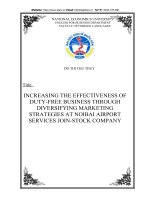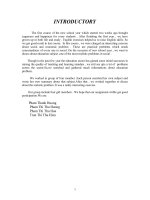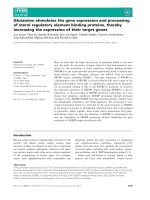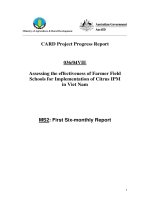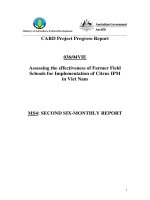INCREASING THE EFFECTIVENESS OF DUTY-FREE BUSINESS THROUGH DIVERSIFYING MARKETING STRATEGIES AT NOIBAI AIRPORT SERVICES JOIN-STOCK COMPANY
Bạn đang xem bản rút gọn của tài liệu. Xem và tải ngay bản đầy đủ của tài liệu tại đây (277.8 KB, 43 trang )
Website: Email : Tel : 0918.775.368
NATIONAL ECONOMICS UNIVERSITY
ENGLISH FOR BUSINESS DEPARTMENT
FACULTY OF FOREIGN LANGUAGES
DO THI THU THUY
Title:
INCREASING THE EFFECTIVENESS OF
DUTY-FREE BUSINESS THROUGH
DIVERSIFYING MARKETING
STRATEGIES AT NOIBAI AIRPORT
SERVICES JOIN-STOCK COMPANY
Hanoi, 05/2010
1
Website: Email : Tel : 0918.775.368
NATIONAL ECONOMICS UNIVERSITY
ENGLISH FOR BUSINESS DEPARTMENT
FACULTY OF FOREIGN LANGUAGES
DO THI THU THUY
Title:
INCREASING THE EFFECTIVENESS OF
DUTY-FREE BUSINESS THROUGH
DIVERSIFYING MARKETING STRATEGIES
AT NOIBAI AIRPORT SERVICES JOIN-
STOCK COMPANY
Field: English for Business Studies
Code: 701
Supervisor: Nguyen Phuong Hoai, M.A
Hanoi, 05/2010
2
Website: Email : Tel : 0918.775.368
TABLE OF CONTENT
Pa
ge
Acknowledgements
Executive summary
List of tables and figures
INTRODUCTION
Rationale of the study
Scope and focus of the study
Research questions
Methodology
Structure of the report
CHAPTER 1. INTRODUCTION OF NOIBAI AIRPORT SERVICES
JOIN-STOCK COMPANY, DUTY-REE DEPARTMENT, DUTY-FREE
SHOPS, THE FORMATION AND CONCEPTS OF DUTY-FREE
BUSINESS
1.1. Introduce NoiBai Airport Services Join-Stock Company (NASCO),
Duty-free Department (DFD) and Duty-free shops
1.1.1. NASCO
1.1.2. DFD
1.2. Formation of duty-free business in the world and in Vietnam
1.2.1. History and development of duty-free business in the world
1.2.2. The formation of duty-free business in Vietnam
1.3. Concepts of duty-free business
1.3.1. Definition
1.3.2. Kinds of duty-free shop
1.3.3. Characteristics of duty-free shops in Vietnam
1.3.3.1. Common characteristics
1.3.3.2. Places of duty-free shops
1.3.3.3. Duty-free goods
1.3.3.4. Persons entitled to purchase goods on sale in duty-free shops
i
Website: Email : Tel : 0918.775.368
1.3.3.5. Duty-free luggage quotas for people on entry at the Vietnamese border
gates
1.4. Problems related to the research topic, research questions,
methodology and score of the research
1.4.1. Rationale of the study
1.4.2. Scope of the study, research questions and methodology
CHAPTER 2: THEORETICAL BACKGROUND OF MARKETING
STRATEGY
2.1. Promoting products: Marketing communication strategy
2.1.1. Steps in developing effective communication
2.1.2. Growth of direct marketing
2.1.3. Integrated marketing communications
2.1.4. Direct marketing
2.2. Promotion products: Advertising, sales promotion, and public
relations
2.2.1. Advertising
2.2.2. Sales promotion
2.2.3. Public relations
2.3. Promotion products: Personal selling and sales management
2.3.1. The role of personal selling
2.3.2. Managing the sales force
2.3.3. Steps in the selling process
CHAPTER 3. ANALYSIS AND FINDINGS
3.1. Result of duty-free business at NoiBai International Airport
3.1.1. Total revenue of duty-free business
3.1.2. Selling duty-free goods on international flights
3.1.3. Selling duty-free goods for people on exit and transit
3.1.3.1. In 2008
3.1.3.1. In 2009
3.2. Duty-free business situation
3.2.1. The rate of growth between goods made in Vietnam and import goods is
not fair
3.2.2. The weakness of advertisement activities, sales promotion, and public
relations
ii
Website: Email : Tel : 0918.775.368
3.2.2.1. Advertisement activities
3.2.2.2. Sales promotion
3.2.2.3. Public relations
CHAPTER 4. RECOMMENDATIONS
4.1. Improving state policies with duty-free goods
4.1.1. Goods made in Vietnam
4.1.2. Goods imported from foreign countries
4.2. Increasing activities of advertising, promotion programs, public
relation
4.2.1. Advertising
4.2.2. Promotion programs
4.2.3. Public relations
4.3. Other recommendations
4.3.1. Increasing the level of penetration and research of customers’ psychology
4.3.2. Investing in facilities and technology equipments for duty-free business
4.3.3. Joining actively duty-free goods fair at countries in region and in the
world
CONCLUSION
REFERENCES
iii
CHAPTER 1. INTRODUCTION OF NOIBAI AIRPORT
SERVICES JOIN-STOCK COMPANY, DUTY-FREE
DEPARTMENT, DUTY-FREE SHOPS, THE FORMATION
AND CONCEPTS OF DUTY-FREE GOODS
This chapter is concerned with some basic information about DFD,
NASCO, duty-free shop formation of duty-free business in the world in general and
in Vietnam in particular, and concepts of duty-free. Besides, readers will have detail
introduction of problems related to the study, scope of the study, research questions,
methodologies and methods of data collection.
1.1. Introduction NoiBai Airport Services Join-Stock Company (NASCO)
and Duty-free Department (DFD) and Duty-free shops
1.1.1. NoiBai Airport Services Join-Stock Company (NASCO)
Noibai Airport Services Join-Stock Company which stands for NASCO
became known as Northern Airport Services Company in Vietnam. It was a state
enterprise established and officially put into operation on July 1
st
, 1993. The company
has been through some dramatic changes to become what it is today.
In May, 1995, Northern Airport Services Company was changed in name to
become NoiBai Airport Services Company – NASCO being a member of Vietnam
Airlines Corporation.
Decision No. 3798/2005/QD-BGTVT dated on May 21
st
, 2005 of the
Minister of Transportation of Vietnam permitting NASCO to be privatized with a
new name “NoiBai Airport Services Join-Stock Company” (NASCO).
On April 5
th
, 2006, according to business laws NASCO officially put into
operation. After privatizing, inheriting and promoting solidary tradition, NASCO has
continued maintaining, and developing and enhancing the effectiveness of “The
Quality management system” with ISO 9001:2000 standard, investing modern
technologies and the structure of management. As a result, the manufacturing
business continues to grow, the brand of company is increasingly prestigious, jobs
and workers’ lives are guaranteed.
In addition to production and business development, social activities are also
always concerned by managers, and most of employees who responded
enthusiastically. Activities of arts and sports are quite vibrant and helps employees
feel relax and work comfortably. Work of returning favor and supporting to victims
1
of wars and those who have difficult situations, etc are held with the order, not only
has contributed to solidarity but also builds cultural lives with a healthy spirit in
company.
On August 13
th
, 2009, with achievements in business production and social
activities after NASCO applies the model of join-stock Company, the President of
Socialist Republic of Vietnam signed the decision to offer NASCO the second-rate
Medal of Labor.
Structure of NASCO is not too complex through the following chart:
Noibai Airport Services Join-
Stock Company
Shareholders
With the clear structure, NASCO becomes popular to public by kinds of
different business. For instance, airport services consists of serving special passengers
2
Supervisors Board of Directors
CEO
Management Units
Service Units
Accounting Dept.
Planning & Investment Dept. NoiBai Aviation Auto Transporter
Duty-free Dep.
NoiBai Aviation Commercial Enterprise
Hotel and tour service agency
NoiBai Aviation General Service Enterprise
NASCO Dept.
Human Resources Dept.
NASCO Branch
like business passengers, first-rate passengers, etc at the airport; using specialized
cars in the aircraft parking; cheking in and checking out for passengers who live in
the city. Services of purchasing, importing, exporting, wholesaling and retailing
goods include duty-free goods, groceries, souvenirs,etc. Transporting passengers by
cars has airport taxi, airport bus. Transporting, preserving, and packaging goods
include courier goods by domestical and international air, customs warehouse,
packaged goods services, etc. Besides, there are also the services of tourist, hotel and
restaurant including domestical and international travel, transit hotel at NoiBai
International Airport, restaurants and coffee bar in inside and outside the airport, etc.
Technological services have lots of functions like maintaining and repairing cars,
motorbikes; industrial hygiene, cleaning environment; industry and civil laundry;
installing electrical equipments. Agencies to provide products and services consist of
selling tickets, life insurance and non-life insurance, exchanging foreign currencies,
providing fuel and liquefied gas.
Therefore, each department of NASCO has its functions and takes an
important role in developing the company. Especially, duty-free department (DFD) is
one of departments which have enjoyed remarkable growth in business.
1.1.2. Duty-free department (DFD) and Duty-free shops
On June 23
rd
, 1990, at NoiBai International Airport, the Ministry of
Commerce of Vietnam issued a license of duty-free business No. 076/TM-DT. The
content of license permitted that NoiBai International Airport could cooperate with
Sundance Duty Free Sales Ltd - a Hong Kong partner in order to open the first duty-
free shop serving exit passengers from Noibai International Airport.
NASCO manages all of duty-free shops at Noibai International Airport.
Duty-free department are directly responsible for selling duty-free goods for
passengers who exit, entry and transit, for international flights of Vietnam Airlines
only and for importing and exporting goods at NoiBai International Airport.
Duty-free shops are retail outlets that do not apply local or national taxes and
duties. In other words, duty-free shops are shops selling goods which are exempted
from export tax, import tax for import-export, transit. They operate under the
regulations issued by the Vietnam government and the license by state agencies.
Duty-free shops appear in many countries in the world and are more and
more developing. Duty-free goods have high quality, famous labels, and suitable
3
price. So, many people usually choose to buy duty-free goods with lots of different
purposes such as decorating, gifting, etc.
NASCO has three duty-free shops in NoiBai International Airport and one
shop in international flight of Vietnam Airlines Corporation. Duty-free shops provide
more than 4500 products. For example: kinds of wine: Cognac, Whisky, Vodka, Gin,
Rum,… importing from France, Italia, Scotland, Canada… with famous labels such
as Remy Martin, Hennessy, Martell, Camus, Chivas, Ballantines, Malibu…
Perfumes, cosmetic and skincare with various fragrances imported from
France, Italia… and famous labels like Christian Dior, Lancôme, Ralph Lauren,
Giorgio Armani, Kenzo, Jean Paul Gaultier, Yves Saint Laurent, and Estee Lauder.
Gifts and Accessories, jewelry and watches, leather and imitation leather
goods with high quality imported famous fashion brands such as Pierre Cardin,
Kahuna, Lacoste, Swiss, Tommy, Hilfiger, Adidas, Cross, Dunhill…
Duty-free goods are imported and controlled strictly about origin, product
quality in conformity with the provisions of relevant Vietnamese laws and
international practices. Besides, prices of duty-free goods can often be driven upward
by the costs of buyer convenience, e.g., in-flight sales by airlines.
Vietnam has no regulations to limit the amount of duty-free goods which exit
and transit passengers purchase at duty-free shops. Passengers can pay in foreign
currency (U.S dollar, Euro) and Vietnam dong (be converted into foreign currencies
under the current average price of Vietcombank)
With the quality management system ISO 9001:2008, structure of goods and
the way of services at duty-free shops of NASCO continuously improved to meet
needs of customers.
1.2. The formation of duty-free in the world and in Vietnam
1.2.1. History and development of duty-free business in the world
Duty-free business appeared in 18
th
century when transport developed in
Europe. Ships which sold products from the mainland to the international waters in
order to buy to merchant ships, the Union sailors, and passengers’ ships ran across the
ocean. Because every item was not sold in the territory of any countries, buyers didn’t
pay domestic consumption tax. As a result, the definition of duty-free goods was set
up.
On March 18
th
, 1947, Irish parliament passed The Customs Free Airport Act,
exit and transit visitors didn’t pay tax for any goods bringing when exiting.
4
On May 18
th
, 1947, the world’s first duty-free shop was established at
Shannon Airport by Dr Brendan O’Regan in Ireland and is in service to this date.
Shannon became a model for other duty-free facilities throughout the world. Since
then, many duty-free shops have opened inside international airports, where visitors
can shop without paying local taxes, or without having to file claims to receive
money back from the country they’re visiting, to cover the money they did pay in
taxes. Such shops usually offer high end or luxury items, which are sometimes
offered at bargain prices. Shoppers may still be limited by customs officials in their
own country as to how much they can legally purchase and bring home without
paying import taxes. Allowance rate for purchases without paying duties varies from
country to country. Designed to provide a service for Trans-Atlantic Airline
passengers typically traveling between Europe and North America whose flights
stopped for refueling on both outbound and inbound legs of their journeys, it was an
immediate success and has been copied worldwide.
In 1996, International Association of Airport Duty Free Stores (IAADFS) is
established to meet the needs of the airport duty-free industry. IAADFS has about 500
subsidiaries and usually held meetings to help subsidiaries have opportunities to talk
and meet with customers at duty-free shops.
On global scale, the largest retail duty-free shops include Abu Dhabi Duty-
free Shop, Bharain Duty- Free, Dubai Duty-Free (in United Arab Emirates), Duty-
free shops at Hongkong International Airport and Blue Water Bridge Duty Free Shop
(in Canada).
About trading duty-free goods at airports, 5 shops having the largest revenue
consist of Dubai, duty-free shop at Heathrow Airport in London, Changi Airport in
Singapore, Amsterdam in Netherlands and Paris in France.
Nowadays, Internet becomes a tool to help businesses develop and help
customers update necessary information about those businesses. And the duty-free
business needs the Internet. In September, 2005, a new website was set up by
Australian - Peter Ellis (). The website support necessary
information about the differences between the price of duty-free goods in flights and
the price of duty-free goods in airport in worldwide. Besides, some of website
appeared widely to advertise and introduce about duty-free business namely such as
, , y-
free.com, , etc. Or customers can access in the website
5
, they will find out immediately information about duty-free
goods in the places they need.
Besides, holding exhibitions from IAADFS about duty-free goods also
attracts amount of large customers who come from many countries. In the history of
global duty-free business, the largest event was the 21
st
TFWA World Exhibition
which was held from October 31
st
, 2004 to November 4
th
, 2004 at Palais des Festivals
at Cannes, France. 500 multinational companies and 5100 visitors coming from 2614
companies joined. So, the exhibition proved that duty-free business has been a
potential industry in the future.
1.2.2. The formation of duty-free business in Vietnam
In Vietnam, duty-free business began to appear in the period when Vietnam
economy opened, the structure of the economy shifted from centralized management
to market economy with the management of the state under socialist-oriented market
economy.
Resolution adopted by the 6
th
National Party Congress in 1986 indicated
Vietnam developed a multi-sector commodity economy under the management of
state. This innovation is an important prerequisite for the formation of duty-free
business in Vietnam.
Opening the economy has helped Vietnam from the period embarking in
implementing innovations to nowadays have profound and comprehensive changes.
Commercial activities have developed rapidly. Thanks to open-door policy,
multilateral policy, diversified policy about externally economic relations, Vietnam
has many relations with many countries and territories around the world.
Premises for duty-free business were the development of foreign trade. So,
with efforts to speed up our economic development, expand trade and cooperate with
many local and regional economic organizations has promoted duty-free business in
Vietnam.
On November 13
th
, 1990, Ministry of Trade and General Department of
Customs published inter-ministerial circular Trade - Customs “Provisions on
organizing activities of duty-free shops at marine ports and international civil aviation
ports”. At first, Ministry of Trade only issued the license for duty-free shops at
NoiBai International Airport, TanSonNhat International Airport, HaiPhong Port and
DaNang Port.
6
Till now, Vietnam has a large system of duty-free shops in many places.
HoChiMinh City has eight duty-free shops including one diplomatic duty-free shop, 1
downtown duty-free shop of Vietnam Maritime Corporation, 1 duty-free shop at
SaiGon Port, five duty-free shops at TanSonNhat International Airport of SASCO (4
exit duty-free shops, 1 duty-free shop in international flight). HaNoi City has 5 duty-
free shops consisting of 1 downtown duty-free shop, 4 duty-free shops of NASCO (3
exit duty-free shops, 1 duty-free shop in international flight). Other countries also
have duty-free shops like HaiPhong, LaoCai, LangSon, QuangNinh, DaNang,
HaTinh, BinhDinh, BaRia - VungTau.
1.3. Concepts of duty-free shop in Vietnam
1.3.1. Definition
Duty-free shops are retail outlets that do not apply local or national taxes and
duties. In other words, duty-free shops are shops selling goods which are exempted
from export tax, import tax for import-export, transit.
1.3.2. Kinds of duty-free shop
There are 5five kinds of duty-free shops in the market. Firstly, duty-free
shops for exit and transit passengers locate behind the place checking customs
formalities and exit formalities of international airports, international borders and
international railway. Secondly, it is duty-free shop in international flights of Vietnam
airlines. Next, duty-free shops for entry passengers are located behind the place
checking entry formalities and in front of the area doing customs formalities of
NoiBai International Airport and TanSonNhat International Airport. Fourthly,
downtown duty-free shops are set up for tourists, overseas Vietnamese. Last kind of
duty-free shop is established according to decree No. 73/CP dated July 30th, 1994 of
the Government on representatives of diplomatic missions, consulate offices and
international organization in Vietnam being entitled to enjoy duty-free quotas.
1.3.3. Characteristics of duty-free shops in Vietnam
1.3.3.1. Common characteristics
The first common characteristic is that imported goods which are sold in
duty-free shops are exempted from import tax, special consumption tax and value
added tax. Secondly, if Ministry of Trade permits imported goods are sold in duty-
free shops in the domestic market, those shops must pay tax in accordance with the
regulations. Thirdly, duty-free business is always controlled by Vietnam Customs,
Ministry of Trade and Ministry of Finance. Next, foreign currency used in
7
transactions at duty-free shops is a freely convertible currency by the Bank of
Vietnam’s announcement. Lastly, Vietnamese enterprises are prioritized to
participating duty-free business.
1.3.3.2. Places of duty-free shops
Duty-free shops are located in international airports, international ports,
international road border-gate, international railway border-gate, international flights,
and domestic market. They are places attracting a huge amount of international
passengers.
1.3.3.3. Duty-free goods
Duty-free products include many kinds. Firstly, duty-free goods include
import goods, domestic goods. Secondly, imported goods put on sale in duty-free
shops shall be affixed “Vietnam duty not paid” stamp. Thirdly, for goods broken in
the course of transportation, the shops shall present certificates of inspection and
written explanations. In case the broken goods are in small quantity or of small value,
the customs offices shall carry out the certification. Fourthly, for goods being
destroyed after expiry dates thereof or goods deteriorated in quality, the shops shall
present certificates of inspection and written explanations. Fifthly, for goods to be re-
exported: upon carrying out re-export procedures, the shops shall present the
following documents: written requests for re-export and permits of Ministry of Trade;
Customs procedures shall be the same as those applicable to re-export of other
consignments of goods.
If the shops’ owners would like to sell the goods to the domestic
consumption, the shops’ owners shall present the following documents: written
requests and permits of the Ministry of Trade; Customs procedures shall be the same
as those applicable to goods imported for business purpose.
1.3.3.4. Persons entitled to purchase goods on sale in duty-free shops
Representatives of Vietnam-based diplomatic missions, consulate offices,
and international organizations eligible to enjoy duty-free quotas; persons on exit;
persons on entry enjoying duty-free quotas; Foreign specialists involving in the
implementation of ODA projects and programs in Vietnam. Besides, the overseas
Vietnamese people who return Vietnam to work at the invitation of Vietnamese State
authorities. Ships’ captains purchasing goods for use during the period the ships laid
at anchor at the harbors or purchasing goods under purchase order for delivery upon
exit.
8
1.3.3.5. Duty-free luggage quotas for people on entry at the Vietnamese
border gates
Ordinal
Number
Belongings and Items Quotas Notes
1 Liquor and alcoholic drinks:
- Liquor of 22% proof or higher
- Liquor of under 22% proof
- Alcoholic drinks, beer
1.5 liters
2.0 liters
3.0 liters
Under-18 people
shall not be entitled
to enjoy these
quotas.
2 Cigarettes:
- Rolled cigarettes
- Cigars
- Shredded tobacco
400 cigarettes
100 cigars
50 grams
Under-18 people
shall not be entitled
to enjoy these
quotas.
3 Tea, coffee:
- Tea
- Coffee
5 kg
3 kg
Under-18 people
shall not be entitled
to enjoy these
quotas.
4 Clothes, personal belongings With reasonable
quantity in service
of the trip’s purpose
5 Articles other than those
mentioned at Items 1, 2, 3 and 4 in
this Appendix
Total value not
exceeding VND
5,000,000
(Decree No. 66/2002/ND-CP of July 1, 2002)
1.4. Problems related to the research topic, research questions, methodology
and score of the research
1.4.1. Rationale of the study
The world’s first duty-free shop was established at Shannon Airport in
Ireland in 1947 and is in service to this date. Duty-free business also entered Vietnam
market in 1990 and has contributed to promote to export, re-export, and increase
foreign exchanges and many different benefits. Furthermore, developing duty-free
business has been cared by many countries in the world.
Duty-free business has been developed strongly in Vietnam airport,
especially Noibai International Airport. The revenue of trading this kind of revenue is
quite large. Law documents about duty-free business are often adjusted, changed in
9
order to create convenient conditions to trade duty-free products. On the February
17
th
, 2009, the Prime Minister Office issued the Decision No. 24/2009/QD-TTg on
the Regulations of the Duty-free shop business, through it: people who enter Vietnam
will not be allowed to buy duty-free products at the duty-free shops. So, NASCO
decided to close one entry duty-free shop at NoiBai International Airport. As a result,
structure of duty-free shop became smaller than before. This cannot be changed
because any reasons. In fact, duty-free goods are good products but there aren’t many
people knowing and buying them. Customers only know those products when they
come to airport. So, marketing strategies are extremely strategies. However, NASCO
hasn’t taken advantages of marketing strategies, duty-free market cannot develop
strongly.
Besides, forms of marketing of NASCO are still simple including brochures,
catalogues. The company hasn’t used other forms like videos, internet, etc. Because
lots of people don’t know this kind of business at NoiBai International Airport, the
revenue of the company decreases. Most of people only know duty-free products if
they have opportunities to come to airport. NASCO hasn’t diversified kinds of
marketing and advertisements. It is difficult for the company to sell products and
develop market. So, marketing strategies are main problems which NASCO hasn’t
solved.
Briefly, problems in developing the marketing strategies and the structure of
trading goods make the development speed of duty-free business at NoiBai
International Airport be slow during many years.
1.4.2. Scope of the study, research questions and methodology
The purpose of this study is to help Duty-free department (DFD) of NoiBai
Airport Services Join-Stock Company (NASCO) change some marketing strategies in
order that duty-free market can develop with larger size and popularize to all
customers through the reality of business. During the internship time, statistics and
figures were collected to help readers have deeper view about situation which
NASCO has been facing.
Figures on Duty-free Department of NASCO including revenue by year,
revenue by quarters will be collected through its annual performance reports. The
study relies mainly on relevant theoretical background, books, statistics, periodic
reports of DFD, analytical method to deal with research questions. The study has
utilized both primary and secondary data. In the first place, primary data aims at
10
finding out the formation and definition about duty-free business at DFD of NASCO.
Theoretical background and articles were collected from DFD, National Economics
University Library as well as Internet – one of the most important tools has useful
functions to finish the report. Moreover, periodic reports are collected from the
NASCO’s DFD. Besides, I also went to duty-free shops at the 2
nd
floor of NoiBai
International Airport to observe and research the way salespeople advertised and sold
to customers. In the second place, the secondary data was obtained through the
company’s website www.nasco.com.vn and its brochures, magazines to see how it
advertises its goods, how it communicates with the publics and what its new
promotion tools are.
To help readers understand the content of the report, I have three questions
which will be answered throughout the report. They will be answered in turn.
1. What are realities of duty-free business at NoiBai International Airport?
2. What should duty-free department do to increase the effectiveness of the
company’s strategy in trading duty-free goods?
3. Whether changes of marketing strategy help increase the effectiveness of the
company’s duty-free goods business?
Briefly, I have just introduced basic information about duty-free department,
NoiBai Airport Services Join-Stock Company, duty-free shops formation of duty-free
business in the world and in Vietnam, concepts of duty-free, problems related to the
study, scope of the study, methodologies, and research questions. To help readers
have a deeper view about problems and can understand recommendations, I will
perform theory background of marketing strategies of this study in chapter 2.
CHAPTER 2. THEORY BACKGROUND OF MARKETING
STRATEGY
Marketing takes an extremely important role in business. If entrepreneurs
don’t use marketing tools, they will have difficulties in developing their business.
However, many people think of marketing only as selling and advertising. Today,
marketing must be understood not in the old sense of making a sale – “telling and
11
selling” – but in the new sense of satisfying customer needs. If the marketer does a
good job of understanding consumer needs; develops products that provide superior
value; and prices, distributes, and promotes them effectively, these products will sell
very easily.
Especially, duty-free business at Vietnam in general and in Noibai
International Airport in particular needs marketing strategy to popular its products to
international market. Considering problems which duty-free department of NASCO, I
want to mention some theories about marketing strategies which are very helpful to
develop this kind of goods. Promoting products including 3 parts: marketing
communication strategy; advertising, sales promotion, and public relations; personal
selling and sales management. But my study only focuses on using marketing
strategies like advertisement, promotion, public relations, I will introduce briefly 1
st
part and 3
rd
part and explore more about 2
nd
part.
2.4. Promoting products: Marketing communication strategy
2.4.1. Steps in developing effective communication
Marketers need to understand how communication works. Two of these
elements are the major parties in a communication - the sender and the receiver.
Another two are the major communication tools - the message and the media. Four
more are the communication functions - encoding, decoding, response, and feedback.
The last element is noise in the system. They are several key factors in good
communication. Senders need to know what audiences they wish to reach and what
responses they want. They must be good at encoding messages that take into account
how the target audience decodes them. They must send messages through media that
reach target audiences, and they must develop feedback channels so that they can
assess the audience’s response to the message. Thus, the marketing communicator
must do the following: identify the target audience; determine the response sought;
choose a message; choose the media through which to send the message; select the
message source; and collect feedback.
Steps in developing effective communication consist of identifying the target
audience, determining the response sought, choosing a message (message content,
message structure, message format), choosing media (personal communication
channels, non-personal communication channels), selecting the message source,
collecting feedback.
2.4.2. Growth of direct marketing
12
